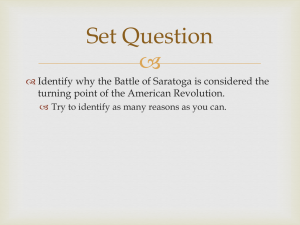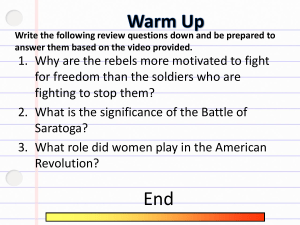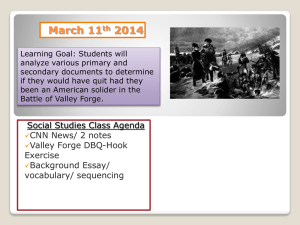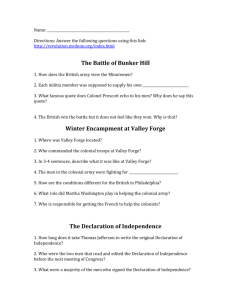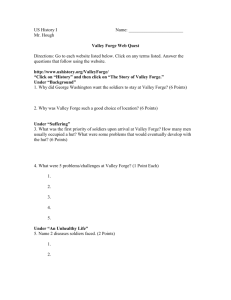Cooks 1 Ricky Cooks 29 October 2012 American History to 1877
advertisement
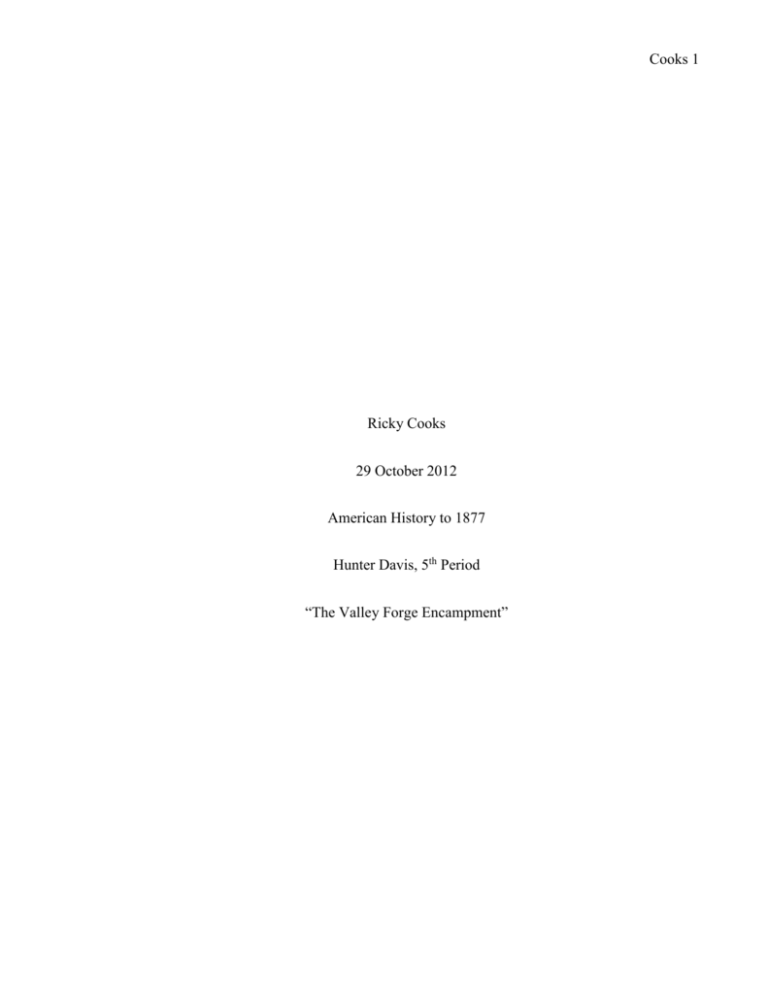
Cooks 1 Ricky Cooks 29 October 2012 American History to 1877 Hunter Davis, 5th Period “The Valley Forge Encampment” Cooks 2 From December 19, 1777 to June 19, 1778, General George Washington trained local men from the colonies to become efficient American soldiers. The men faced harsh weather and suffered from starvation and sickness. Valley Forge, Pennsylvania has been “considered the birthplace of the American Army,” ("Valley Forge, Pennsylvania") because it made the scared, unorganized, untrained soldiers from the losing side of a war independent and stronger. Valley Forge is one of the events that changed the outcome of the American Revolution. In September of 1777, Major General William Howe moved his troops to the largest city in the colonies at the time, Philadelphia, Pennsylvania. He hoped that “the capture of the rebel capital would end the war” (Avery). Washington failed to stop Howe before he and his troops reached Philadelphia. Members of Congress wanted Washington to attack Howe’s troops in Philadelphia, but after losing many battles before because of untrained soldiers, Washington knew that the effort would be pointless unless the Colonists Army was better trained. The cold winter weather slowed the fighting, and Washington decided his men needed a place that could “afford supplies of provisions, wood, water and forage, be secure from surprise and best calculated for covering the country from the ravages of the enemy" (Avery). He chose Valley Forge, Pennsylvania, near the Schuylkill River. After eight long days of marching through treacherous weather conditions, Washington’s troops finally arrived at Valley Forge, a high plateau protected by a river and two creeks only about twenty-five miles away from Philadelphia. It was a great place for military troops to post. The troops thought that arriving at Valley Forge had ended their hardest challenge, but worse conditions awaited them. Over four inches of snow covered the lands, and food and other supplies were scarce. The daily meals for most of the encampment consisted of fire cakes, which Cooks 3 was a fried flour and water mix. Soldiers lacked clothing and shoes, and most of the time they had to make shoes out of animal hides, which didn’t protect them from the cold temperatures. Some volunteers “made clothes for the troops and cared for the sick” (Appleby 173). “Every 12 men would share a 16x14 foot long hut with walls six and a half feet high” (Avery). “The huts were drafty, damp, smoky and terribly unhealthy” (Avery). Disease spread was also a huge problem at the camp for the troops. “Dysentery and typhus were rampant” (Avery). Without sufficient supplies, the sick troops couldn’t be treated efficiently. “Conditions were so severe at times that General Washington wrote, ‘that unless some great and capital change suddenly takes place... this Army must inevitably... starve, dissolve, or disperse, in order to obtain subsistence in the best manner they can’” ("U.S. National Park Service"). After months of unbearable conditions, the weather started to warm up. Baron Friedrich von Steuben of Germany came to the Valley Forge encampment and was appointed by Washington to “oversee the training and discipline of the army” (Hickman). Not able to directly instruct the troops through voice, he employed a group of one hundred men who knew the drill well. Using this method, von Steuben trained the Continental Army to be more efficient and effective. Also, von Steuben helped sanitize and organize the encampment to help it run more smoothly. The soldiers were less sick, thus growing stronger and more confident in their cause. Because of von Steuben’s great contribution to the once dreadful and hopeless encampment, General Washington gave him “the rank and pay of a major general” (Hickman). On May 20, 1778, the newly trained Continental Army won their first battle against Britain since the encampment. British troops “from Philadelphia attempted to trap 2,200 Continentals defending Valley Forge led by Marquis de Lafayette” (History.com). Lafayette was aware of the British’s plan to ambush them, and with the help from the Oneida Native Cooks 4 Americans, they escaped. General Clinton, who had replaced General Howe, left Philadelphia, handing the reins of the city back to the colonists. On June 19, 1778, after six months of hardship and struggle, the troops “marched away from Valley Forge in pursuit of the British who were moving toward New York” (“U.S. National Park Service”). “Washington's troops emerged to pursue and successfully fight Lt. Gen. Sir Henry Clinton's British Army at the Battle of Monmouth in New Jersey” (“U.S. National Park Service”). “The ordered ranks, martial appearance, revived spirit, and fighting skill of the American soldiers showed that a great transformation occurred amidst the cold, sickness, and hardship that was Valley Forge” (“U.S. National Park Service”). The trained army won many more battles against the British, with the help of the French and Native Americans. All of the fighting led to the Siege of Yorktown, from September 28 to October 19, 1781. The colonists and the French sieged the British, who were outnumbered. After twenty-two days of battle, General Cornwallis of Britain surrendered and the colonists won the war and their independence. The Continental Army, a weak bunch of men who had little to no experience in fighting, trained and persevered until victory. In more ways than one, the encampment at Valley Forge greatly affected the outcome of the American Revolution. It changed unfit soldiers into heroes of the Revolution; a hopeless group of misfit colonists into soldiers of the soon-to-be strongest nation in the world; and changed a ridiculed group of British colonies to an independent, proud, and admired country. The struggle of the brave men from Valley Forge is a reminder to us today it could always be worse, and that so much more could be at stake. The real turning point of the American Revolution is the encampment of Valley Forge from December 19, 1777 to June 19, 1778. Cooks 5 Bibliography "Fact Sheet." Valley Forge, Pennsylvania. N.p.. Web. 23 Oct 2012. <http://valleyforge.org/visitors/media/fact-sheet/>. Avery, Ron. "The Story of Valley Forge." Historic Valley Forge. N.p.. Web. 23 Oct 2012. <http://www.ushistory.org/valleyforge/history/vstory_background.html>. Appleby, Joyce, James McPherson, Alan Brinkley, Donald Ritchie, and Albert Broussard. The American Republic to 1877. Glencoe McGraw-Hill, Print. Hickman, Kennedy. "American Revolution: Baron Friedrich von Steuben." About.com. N.p.. Web. 23 Oct 2012. <http://militaryhistory.about.com/od/americanrevolutio1/p/AmericanRevolution-Baron-Friedrich-Von-Steuben.htm>. . "Battle of Barren Hill." History.com. N.p.. Web. 23 Oct 2012. <http://www.history.com/this-day-in-history/battle-of-barren-hill-pennsylvania>. Cooks 6 Brier, Marc. "Tolerably Comfortable: A Field Trial of a Recreated Soldier Cabin at Valley Forge." Tolerably Comfortable: A Field Trial of a Recreated Soldier Cabin at Valley Forge. n. page. Web. 23 Oct. 2012. <http://www.nps.gov/vafo/historyculture/upload/tolerablycomfortable.pdf>. . "The Battle of Yorktown 1781." British Battles.com. N.p.. Web. 27 Oct 2012. <http://www.britishbattles.com/battle-yorktown.htm>. . "Valley Forge Encampment." U.S. National Park Service. N.p.. Web. 28 Oct 2012. <http://www.cr.nps.gov/logcabin/html/vf.html>.
